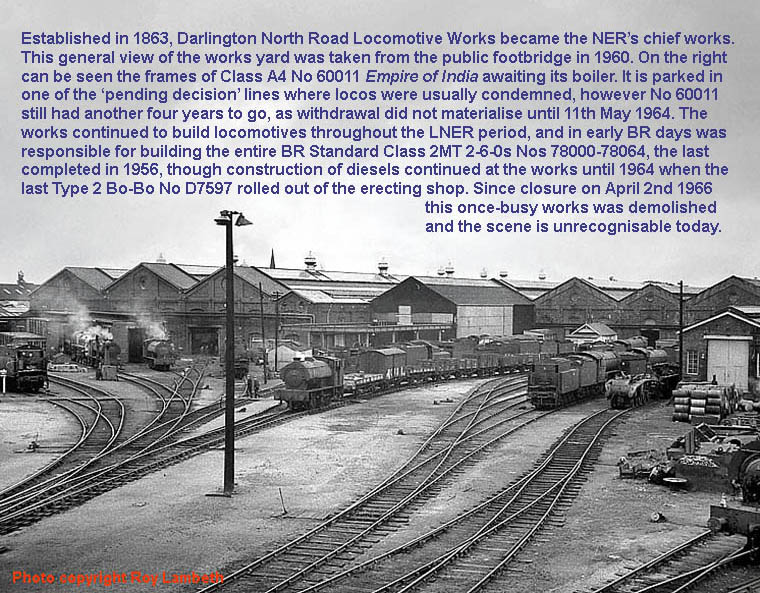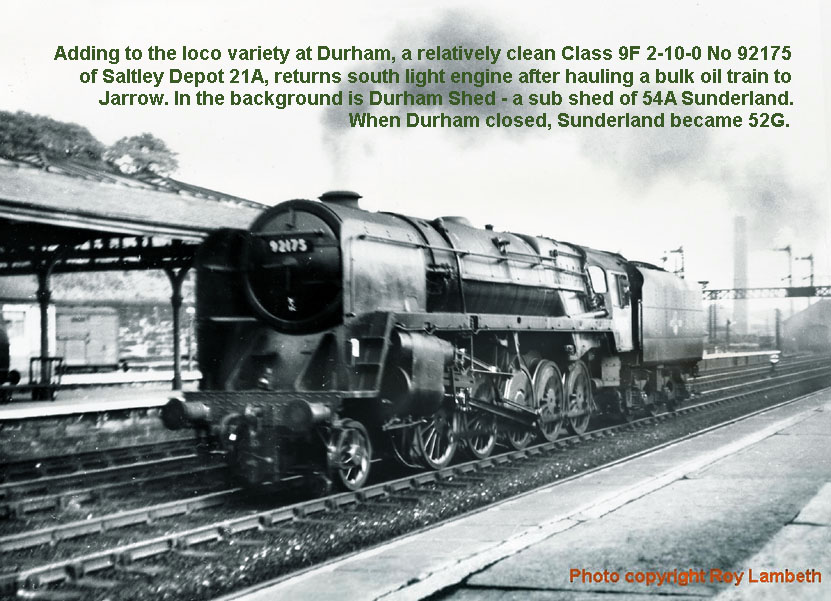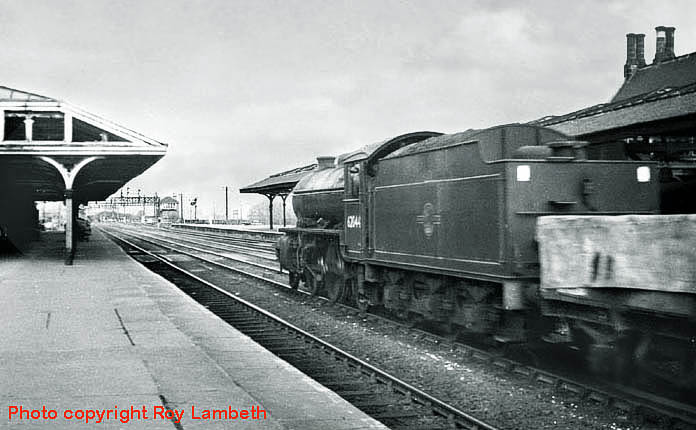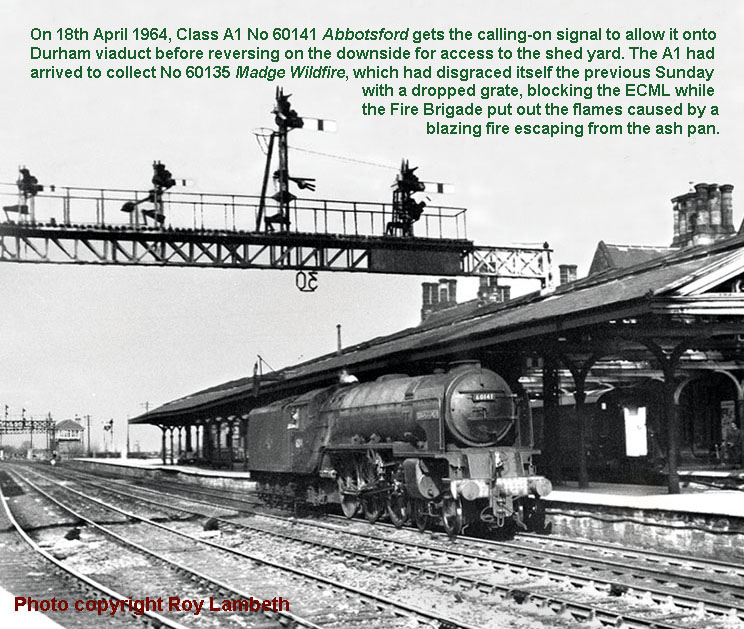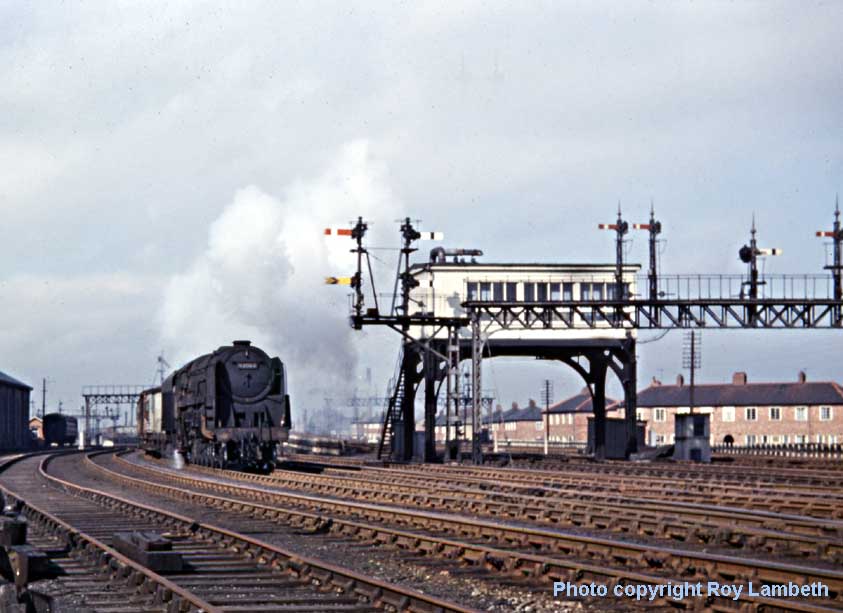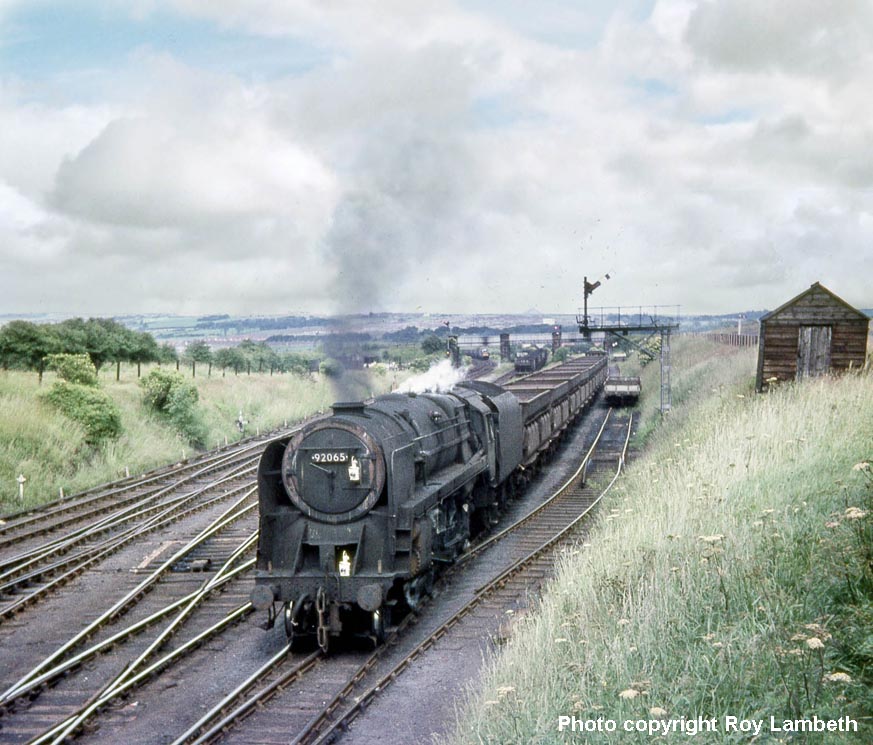When the British Transport Commission (BTC) announced the Modernisation Plan for British Railways (the emphasis being the ultimate replacement of steam by diesel and electric traction) the train spotting fraternity soon realised that its cosy perception of the future was about to change. Harking back to the days before the Whitehall bureaucrats started meddling with Britain's rail network, the chance of spotting a speeding Gresley A4 'Streak' at the head of a crack Anglo-Scottish expresses was always worth waiting for, but as the years rolled by it quickly dawned on us that the elderly statesmen of steam had become inconsequential and had had their time - BR's top link steam fleet was on its way out.
 By 1962, the Class 55 'Deltics', Class 40 'Whistlers' and Class 45/46 'Peaks' were making major inroads on the ECML, and with the demise of the Gresley racehorses gathering pace, train spotters stood side by side at the ends of station platforms - mostly in silence, I grant you. But nothing in life could have prepared us for the effect that modernisation was going to have on the hobby. Gone were the days when the sight of a Class A4 'Streak' could turn even the most placid kid into an emotionally erratic hysteric! For countless thousands of small boys in short pants it was an outpouring of unashamed emotion; the sort of dottiness that we have come to accept from a small boy with an uninhibited passion for steam trains. But as the rank and file of steam began to wane, our attitude towards the new diesels slowly changed, though this was probably due to the dire state of steam than the statesmanlike look of the diesel fleet.
By 1962, the Class 55 'Deltics', Class 40 'Whistlers' and Class 45/46 'Peaks' were making major inroads on the ECML, and with the demise of the Gresley racehorses gathering pace, train spotters stood side by side at the ends of station platforms - mostly in silence, I grant you. But nothing in life could have prepared us for the effect that modernisation was going to have on the hobby. Gone were the days when the sight of a Class A4 'Streak' could turn even the most placid kid into an emotionally erratic hysteric! For countless thousands of small boys in short pants it was an outpouring of unashamed emotion; the sort of dottiness that we have come to accept from a small boy with an uninhibited passion for steam trains. But as the rank and file of steam began to wane, our attitude towards the new diesels slowly changed, though this was probably due to the dire state of steam than the statesmanlike look of the diesel fleet.
This brings me to the fantastic railway photographs of Roy Lambeth, who contacted me on the Guest Book page with a view to sharing his photos with the world. I'm pleased that he chose this site for two reasons. First, his collection of photos from old steam days are superb, and second - the World Wide Web is a great way of making new friends, and Roy is one of the nicest people I've met on the net. Okay, we might occupy our own little hermetically sealed worlds in a solitary fashion on our computers, but nostalgia for the old days is such a powerful emotion that we all want to share it with others. In fact, it wouldn't surprise me that on the very same day my big sister was taking me train spotting to Thirsk station in the summer of 1955, a young seven year-old Roy Lambeth was accompanying his dad on a visit to Wharton Park in Durham. His dad chose a vantage point just behind Durham South Signal Box where they could watch trains crossing Durham viaduct, and it was this visit that started Roy's lifetime love of steam and railways. So if your own childhood reminiscences include the smell of engine sheds filled with acrid smoke, hot oil and steam, Roy's stories will bring back many more pungent memories…

(Above) During the 1950s-1960s my father was an H.M. Inspector of Fertilisers & Feedstuffs, whose job required him to visit places where such items were stored. This included Co-ops and pet shops, and every railway goods shed in County Durham. I accompanied him during the school holidays and got to know quite a few railway staff, particularly on the Wear Valley Branch where the Stanhope station staff was very friendly. In the days before the Eastgate Cement Works was opened, there were two daily freights bringing box vans of fertilisers and animal foods, coal & coke, and empty mineral wagons to be loaded with stone from the quarries. I managed to hitch a footplate trip on the morning goods from Stanhope up the valley, and this shot of Standard Class 4 2-6-0 76050 at Eastgate Station was taken by the fireman of me in the driver's seat in Summer 1961. This West Auckland shed's Standard Class 4 2-6-0 was a regular on this branch after the West Auckland resident Class J26 No 65735 was withdrawn, but on closure of the shed No 76050 was transferred to Hawick for banking duties to Whitrope Summit on the Waverley Route. The loco was the last member of the class to survive.
DURHAM STATION AND ITS BANKERS
I did not start spotting at Durham until the very end of the A8 era. The elderly Class A8 4-6-2Ts were used as Durham Bankers before the Class V1/V3 2-6-2Ts took over. The Gresley V1/V3s stayed on banking duties prior to dieselisation, however a couple of years before the end of steam the banking duties were transferred to both Heaton and Gateshead Depots. During the Sunderland days we occasionally had other locos on the banking duties. One Saturday I remember Class B1 61012 Puku. On another occasion a Fowler 2-6-4T 42411 appeared. During the latter days sometimes ex-Scottish V1/V3 tanks were used while they were waiting for space at Darlington Scrap Yards. During steam days, Durham Station consisted of 7 platforms plus 2 docks. Platform 1 was the down parcels siding, platform 2 the Sunderland passenger platform, platform 3 down through, platform 4 up through, platform 5 Sunderland arrivals, platform 6 Bishop Auckland departures and platform 7 up parcels. There was a long siding around the back of the down platform buildings where outside cylindered locos were not allowed, and outside the South end of the up platforms was a very short dock, known as the Fish Dock which I never saw used. In early days, before Durham was part of the ECML, this fish dock extended under the roof mounted water tank and was used as an engine shed for one loco. This was discontinued when the Tursdale - Durham - NewtonHall - Chester-le-Street was opened.
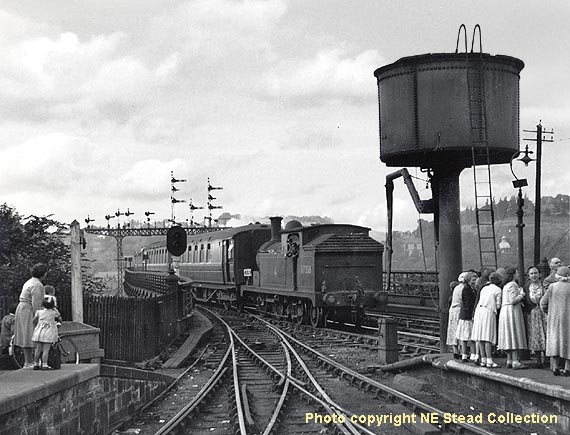
(Above) In pre-diesel days, Durham had a 2-road engine shed with an allocation of class G5 0-4-4T locos. These were used on the Sunderland/Durham/Bishop Auckland/Barnard Castle services and they were also used to bank the southbound stopping passenger trains over the steep curving viaduct. There was a short spur by Durham North Signal Box used as a banker refuge. When the DMUs replaced steam on the branch passenger services, the G5s were withdrawn and the shed closed. The staff went to their parent shed at Sunderland South Dock, which then had an allocation of Class A8 4-6-2T passenger tanks that had been made redundant on coastal passenger services. Here, looking very much like a 'Ladies Day Out' - all in their Sunday-best frocks, ribbons, bows, bobby socks and sandals - Class G5 0-4-4T No 67258 banks a southbound train on the climb out of Durham
(Above) With the ever-increasing demand for faster speeds on the East Coast Main Line, this wide view of Durham station and, for that matter the First Generation DMUs, are now but just a memory. On a warm & sunny Saturday afternoon in 1960, Roy photographed a 2-car Met-Cam DMU from Sunderland arriving at platform 4 bound for Bishop Auckland. Some Durham staff members called the Durham-Sunderland trains 'Sunderland Flyers' and trains to Bishop Auckland the 'Brandon Bus'. The station layout has changed considerably over the years, with ECML electification, major trackwork alterations and the replacement of aged semaphore type mechanical signalling by more modern multiple aspect signalling. The current track layout at Durham assumed its new guise in December 1969, when the four tracks were reduced to two 'down' lines and one 'up', and connections to the bays were removed. The remodelling allowed the 'up' platform to be set back allowing the 30mph speed limit on the approach to the viaduct to be raised to 50mph. The chimney pots on the right belong to the now-demolished Station Hotel.

 By far the busiest day in Durham station's calendar was the annual Durham Miners Gala. Established in 1871, the Gala is held in Wharton Park just behind the railway station - the 125th Gala will be celebrated in 2009. In the days when County Durham had more than 150 collieries, the annual Gala was held on the first day (Saturday) of the miners traditional two weeks summer holiday in June. Since this was much earlier than the school holidays, children from mining families had 8 weeks school holidays each year instead of the average six. The Gala consists of a march through the City with Brass, Scottish Pipe or Military Bands followed by politcal speeches by members of The Labour Party and invited guests from other unions. Each colliery had a Miner's Lodge which was a branch of The National Union of Mineworkers. Each lodge had a brightly coloured silk banner, measuring up to 11 ft square, which was paraded behind the band followed by Union members and their families. On Miners Gala Day, trains arrived approximately every 7 minutes between 6am and 11am. Then from 3pm in the afternoon there were regular departures of Gala specials until very late evening. Almost every colliery had a rail access, often on freight-only lines where passenger stations that had been closed many years would open up for this one day only. Each Miners Lodge would hire at least one train, usually consisting of six non-corridor coaches which would take their band, banner and supporters to and from the Gala. (Below) Class J39 64853 at Durham Station on 15th July 1961 with a Miners Gala Day Special from Waterhouses on the freight only Deerness Valley Branch.
By far the busiest day in Durham station's calendar was the annual Durham Miners Gala. Established in 1871, the Gala is held in Wharton Park just behind the railway station - the 125th Gala will be celebrated in 2009. In the days when County Durham had more than 150 collieries, the annual Gala was held on the first day (Saturday) of the miners traditional two weeks summer holiday in June. Since this was much earlier than the school holidays, children from mining families had 8 weeks school holidays each year instead of the average six. The Gala consists of a march through the City with Brass, Scottish Pipe or Military Bands followed by politcal speeches by members of The Labour Party and invited guests from other unions. Each colliery had a Miner's Lodge which was a branch of The National Union of Mineworkers. Each lodge had a brightly coloured silk banner, measuring up to 11 ft square, which was paraded behind the band followed by Union members and their families. On Miners Gala Day, trains arrived approximately every 7 minutes between 6am and 11am. Then from 3pm in the afternoon there were regular departures of Gala specials until very late evening. Almost every colliery had a rail access, often on freight-only lines where passenger stations that had been closed many years would open up for this one day only. Each Miners Lodge would hire at least one train, usually consisting of six non-corridor coaches which would take their band, banner and supporters to and from the Gala. (Below) Class J39 64853 at Durham Station on 15th July 1961 with a Miners Gala Day Special from Waterhouses on the freight only Deerness Valley Branch.

 During the day while the marches and speeches of this huge political demonstration took place, every siding within five miles of Durham would be full of simmering steam locos coupled to rakes of coaches waiting to return to Durham to collect their passengers. During the 1950s, there would be up to fifty trains stabled at Relley Mill - as many as five in any one long siding, with a lot of shunting going on, and every loco making use of the water columns before being stabled. Today, the Durham Miner Gala is nowhere near as big as it used to be, but it is still Europe's largest annual political gathering with around forty original and replica miners banners and a further 100 banners from other unions including UNISON, ASLEF, NUR, T&GW, GMB, as well as miners banners from other areas including South Wales, Nottinghamshire and Yorkshire. Since closure of the collieries, the railways have also closed; nowadays all the banners arrive by bus and Durham Station no longer accommodates these special trains.
During the day while the marches and speeches of this huge political demonstration took place, every siding within five miles of Durham would be full of simmering steam locos coupled to rakes of coaches waiting to return to Durham to collect their passengers. During the 1950s, there would be up to fifty trains stabled at Relley Mill - as many as five in any one long siding, with a lot of shunting going on, and every loco making use of the water columns before being stabled. Today, the Durham Miner Gala is nowhere near as big as it used to be, but it is still Europe's largest annual political gathering with around forty original and replica miners banners and a further 100 banners from other unions including UNISON, ASLEF, NUR, T&GW, GMB, as well as miners banners from other areas including South Wales, Nottinghamshire and Yorkshire. Since closure of the collieries, the railways have also closed; nowadays all the banners arrive by bus and Durham Station no longer accommodates these special trains.

(Above) In the summer of 1964 just before final closure of the Deerness Valley Branch (closed 28th December 1964) Class K1 62048 arrives at Ushaw Moor Station with a Bearpark Colliery Sunday School outing to South Shields. The passengers had been brought to Ushaw Moor over the hill from Bearpark in a fleet of United service buses which were waiting for the train's return. The train consisted of 6 non-corridor compartment stock coaches. There were over 500 of these coaches stored at various locations around County Durham and many were only used one day a year - Durham Miners Gala.
(Below) One summer afternoon in 1962, while train spotting at Durham, my school pals Chris Sands, John Drain and I saw a long PW train parked north of the station area. After a while a loco arrived from the north and hooked up to the train, but did not move for some time, so we walked up the fields to see its identity. We were told it was getting ready for overnight PW work and was not going anywhere, so we all cabbed the loco. Here, sporting short back 'n' side and jeans with turn-ups, Chris Sands (left) and John Drain (right) await their turn on the footplate of Class Q7 63470. The closed Durham Shed can be seen in the distance.
During the night, 2 refrigerated fish vans (often long wheelbase 'Blue Spot' vans) would arrive at Durham and by time I got to the station for a day's spotting they had been unloaded and shunted into the Shed Yard. The banker had already arrived from Sunderland, picked up the two fish vans and a goods brake van and shunted them into platform 7. It would then take on water on platform 4 and run wrong line to its refuge by the North Signal Box in readiness to bank the 07.22 to Bristol, 07.46 Kings Cross, the 08.08 Kings Cross (this was the Deltic hauled express which was non-stop from Darlington and was the fastest train in the UK at the time; 268 miles in 4 hrs 15 mins), 08.39 to Swansea, 08.44 to Kings Cross, 08.51 to Bournemouth, then it had other work to do before being required to bank the 10.34 to Kings Cross.
(Above-Below Left) I knew most of the Durham station staff as some of them lived close by and others had children of my age. I spent many hours in the Porter's Room on the down side, or with Billy White in the Left Luggage Office on the up side. Also, one of my school pals's dad was manager of W.H.Smiths wholesale newspaper warehouse on the down side, so I could often be found in there helping out during the early hours of Saturday mornings. I was accepted by the Station Master, and all but one of the Station Inspectors as well as the locally based Railway Police. One of my regular jobs was to be at the bottom of the barrow lift to transfer the barrows under the tracks from one platform to the other. I could see the wheels of passing trains through the windows in the platform edges, and the number of the loco would arrive chalked onto the next barrow to come down the lift. (Below Left) This lady was the Durham station cleaner, taking a well deserved break in the Left Luggage Office. She cleaned all the offices and the hotel - all on her own…

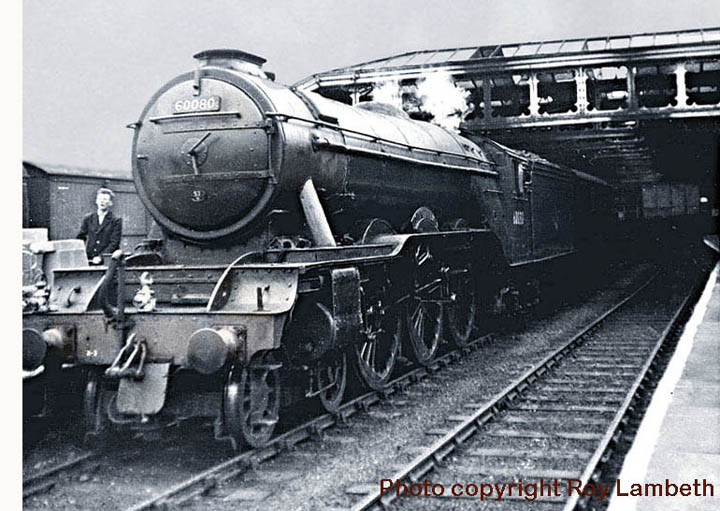
(Above Right) The afternoon banking shift was a lazy affair with very little to do until about teatime when the banker would go light engine to Fencehouses to collect a bogie brake full of parcels and mail for London. Sometimes there would be two bogies at Durham, the other having been sitting at the buffers for a couple of days loaded with carpets from Hugh MacKays 'Durham' Carpets and locally-made 'Richmond' sausages and pies. Depending on the time available between banking duties the coach would either be dropped in to platform 6, or run round and propelled into platform 5. It was attached to the nightly Kings Cross parcels - see photo (right). If in platform 6 it was picked up by the train engine, but if in platform 5, the banker would have to do the job, so it was usually to be found in platform 6. The last three banking duties of the day were the Bristol sleeper, Kings Cross parcels and Kings Cross Sleeper after which there would be a high speed hurried departure for its home depot. This is Durham platform 6 - and on this occasion Class A3 No 60080 Dick Turpin collects the bogie parcels coach (ex-Fencehouses) to be added to the Kings Cross Parcels, which is standing on the main line platform.
If I was known by the banker crew, they often allowed me on the engine. The job of the banker between 08.51 and 10.34 was to take the 2 fish vans to Broompark sidings at the end of the Dearness Valley line and to replenish the water supply (in churns) to the 5 signal boxes round The Relley Mill Junction area just South of Durham. If I agreed to deliver the water, then I would be able to travel on the loco. If I did not know the crew, I would travel in the Guards van and pass the water down to the crew at each box. That way they soon got to know me. If I was travelling with them on a particular day, before 08.51 I would have collected the empty water churns from the Brake Van, washed them out and refilled them in a large low sink in the Left Luggage Office, and put them back in the brake van. After banking the Bournemouth, the banker would drop down onto the assembled train in platform 7 and we would set off. We went straight down the main line to Bridge House Junction (where the line from Consett met the ECML) then we would be propelled wrong line to Baxter Wood Nos.1 & 2, then to Dearness Valley Junction, where I'd often take the water up the long flight of wooden steps to the box while the fish vans were shunted off and the brake van was run round (see photo below). Then it was to Relley Mill Box for the final water drop before rushing back to Durham, drop the brake van in platform 1 where it would run by gravity back into the shed yard, while the banker crossed the 4 tracks in time to bank the 10.34 Kings Cross. Once a month there was an extra duty to perform - supplying each signal box with a can of lamp oil for all its signals.
(Below) Introduced to traffic in 1939, Gresley's sturdy Class 'V3' 4MT 2-6-2T was a development of his less powerful Class 'V1' 3MT 2-6-2T introduced in 1930, though both classes were externally undistinguishable. Here, Durham banker No 67690 runs into Broompark coal stocking sidings where it will leave its train of two box wagons before running round the brake van for the return to Durham shed yard. During the winter of 1962/63 I did my first unofficial firing turn on V3 67690. It was a sunny and frosty Sunday and both the banker's crew were passed firemen who had once worked at the Durham Shed, and one of them still lived in Durham. We had heard that parts of the River Thames and the River Tyne were frozen, and the colliers could not get the coal to London for the power stations or the gas works, so the coal was being taken in 60 wagon load trains down the ECML hauled by anything that was available including classes A4, A3, A2, A1, V2 and double headed B1 & K1s. They all stopped at Durham to top up water as they would not be going fast enough to use water troughs. So each one had to be banked. I arrived just after lunch and was promptly told that I was the fireman (I was just 14 yrs old) while the fireman went home for lunch. I spent a happy 3 hours learning the job of a fireman while banking train after train. At the end of the shift the banker would head off back to its depot. The mid-morning trains were fairly light and managed without banking. The next shift would arrive, often in a hurry behind The 'Northumbrian' express to Kings Cross. This was regularly loaded to 13 coaches and on summer Saturdays often had a 13 coach relief as well. The main train was regularly hauled by one of two class A2s 60538 Velocity or 60539 Bronzino
(Above-Below) Class K1 No 62041 has just left the ECML at Bridge House Junction and is about to pass beneath the Durham-Bishop Auckland line on its way to Consett with a train of spoit ballast. In the foreground, the effect of mining subsidence on the permanent way is much in evidence. This was a regular occurence in the South Durham Coalfield and weekend engineering teams were kept busy keeping on top of it. (Below) Class O1 No 63856, one of the Westinghouse Braked-fitted 2-8-0s from Tyne Dock Depot, waits at Dearness Valley Junction on the Bishop Auckland-Durham line, heading for another load of coal for the coke works at one of the South West Durham Collieries.
 (Above & Left) Returning to Durham station, Class K1 No 62044 heads north with a semi-fitted freight on July 21st 1962. (Left) With hindsight, I regret not spending more time photographing the Durham Bankers and the procession of coal trains that stopped at Durham Station to top up the tenders with water. But the little time I did spend there was great fun and I have only happy memories...on a date in 1963, several of us 'in the know' went to Durham Station especially to see the pioneer Class V2 No 60800 Green Arrow heading south into preservation.
(Above & Left) Returning to Durham station, Class K1 No 62044 heads north with a semi-fitted freight on July 21st 1962. (Left) With hindsight, I regret not spending more time photographing the Durham Bankers and the procession of coal trains that stopped at Durham Station to top up the tenders with water. But the little time I did spend there was great fun and I have only happy memories...on a date in 1963, several of us 'in the know' went to Durham Station especially to see the pioneer Class V2 No 60800 Green Arrow heading south into preservation.
 (Above) In 1964, my local goods branch finally became dieselised. In the ten years I had watched the afternoon freight at various points along the route (mainly from the bottom of the lane at the end of my street) I witnessed the regular loco haulage change from Class J21, through classes J39 & Q6 to this Clayton Type 1 then finally BR Sulzer Type 2s. The funny thing is, if you took any of the J21s that appeared, removed the BR '6' prefix and replace it with a 'D' then the Sulzers had the same numbers as the J21s. (Above) No D8608 was photographed from the footbridge performing the same duties at Durham Gilesgate Goods. The diesel fly shunting was never as effective as steam days. After Gilesgate station closed in 1965 the building became a Travel Lodge and the track bed now forms part of the A690 dual carriageway from Durham to Sunderland.
(Above) In 1964, my local goods branch finally became dieselised. In the ten years I had watched the afternoon freight at various points along the route (mainly from the bottom of the lane at the end of my street) I witnessed the regular loco haulage change from Class J21, through classes J39 & Q6 to this Clayton Type 1 then finally BR Sulzer Type 2s. The funny thing is, if you took any of the J21s that appeared, removed the BR '6' prefix and replace it with a 'D' then the Sulzers had the same numbers as the J21s. (Above) No D8608 was photographed from the footbridge performing the same duties at Durham Gilesgate Goods. The diesel fly shunting was never as effective as steam days. After Gilesgate station closed in 1965 the building became a Travel Lodge and the track bed now forms part of the A690 dual carriageway from Durham to Sunderland.
(Below) I was friendly with the Durham Area relief signalman, Fred Rickerby, who lived just 3 doors from our house in Durham. It was through my friendship with Fred that I gained access to several signal boxes in the Durham area including Bridge House (South end of the Relly Mill junctions), Durham South, Durham North, Newton Hall Junction - all on the ECML - plus I enjoyed visits to boxes at Whitwell, Sherburn North, Auckland Junction and Fencehouses on the Leamside line. One Sunday in 1965 I spent a shift with him at Whitwell Box which controlled a farm crossing between Sherburn and Shincliffe. During the afternoon I managed to catch both the Deltic and the Brush Type 4 D1538 on 'up' expresses diverted from the ECML due to a failure on Durham Viaduct.
(Below) The rural scene from Stanhope Signal Box as a Class 24 from Darlington Shed complete with Brake Tender crosses the River Wear with the daily Weardale Morning Goods. These diesels from either Darlington or Thornaby had replaced the then closed West Auckland steam allocation and the drivers were nowhere near as friendly as the West Auckland men, so I never managed any more footplate trips...

(Above-Below) My visits to the ECML were not confined to the Durham area. During a day trip to York on 3rd September 1963, I was approached by a group of enthusiasts on their way to Doncaster Plant and accepted their invitation to join them on a works visit, only to find that when we arrived at the entrance there had been a serious accident on the premises and all visits had been cancelled at short notice. At that time, dieselisation was making major inroads in the North-East, but there was still plenty of steam-hauled freight and the odd passenger turn to be found, while at York there was an active steam shed but most of the passenger work was diesel. At Doncaster however, apart from 2 dead Class J50 0-6-0Ts in the sidings adjacent to the station we never saw a steam engine. (Above) Brush Type 2 No D5845 passed through on 'up' iron ore empties; this was the first time I had seen a member of the class. I was familiar with the new Standard Type 4 2,750hp fleet, of course, their initial allocation on the ECML provided a valuable standby locomotive for the Deltic fleet, particularly as the earlier and less-powerful D200s and 'Peak' classes were being pushed to their limits. No D1517 was the loco hauled us from York to Doncaster.
(Below) When the Deltic fleet took over the Anglo-Scottish expresses the heydays of Class A4s' reign on the ECML were numbered, but not for the greater good - thank goodness! During the early days of the preservation movement, the Gresley A4 Pacific became a popular candidate and no fewer than six have survived the cutters torch - which, not surprisingly, included No 4498, the 100th Gresley Pacific to be built. The A4 was fittingly named Sir Nigel Gresley after its designer on 26th November 1937. Following withdrawal from traffic on February 1st 1966, the A4 found a saviour with the A4 Locomotive Society and subsequent refurbishment at Crewe Works. The Society has evolved into the 'Sir Nigel Gresley Locomotive Preservation Trust Ltd. In this vew of Durham North, Roy captures something of his old spotting days as No 4498 heads north with a steam special in 1966.
CLASS 9F SWANSONG - TYNE DOCK TO CONSETT
The history of the Tyne Dock-Consett line dates back to September 1834 when the Stanhope & Tyne Railway built a series of rope worked inclines from Crawleyside at Stanhope to South Shields. In 1841 the company failed and the line was divided into two parts with the Conside (Consett) to South Shields section becoming the Pontop & Shields Railway, while the Conside-Stanhope line came under the auspices of the Derwent Railway, operated by the Derwent Iron Co (later Consett Iron Co, then Consett Steel Works).
(Above - Inset Left) The heavy iron ore traffic from Tyne Dock to Consett gave lineside photographers a wonderful opportunity of taking action shots of steam at work. (Above) Riddles Class 9F No 92063 makes a magnificent spectacle as it leaves its banker behind at Simonside and passes beneath the 71-lever Green Lane Bridge box on its way to Consett with a train of iron ore on 25th April 1966. The mass of lines all belonged to BR giving access to various parts of Tyne Dock Bottom and Tyne Dock Coal Staithes. The upper quadrant signals are on the BR operated lines and the lower quadrant signals are on the BR lines used by the NCB, all controlled by the BR signal box. (Inset Left) Awaiting banking assistance at South Pelaw Junction, the crew of Class 9F 92060 - a loco seemingly leaking steam everywhere, and stationary  right across the junction - attempt to get a full head of steam and a big fire required for the gruelling 1 in 36 climb ahead to Consett. On the right, sister 9F 92099 passes with a brake van in readiness for another load.
right across the junction - attempt to get a full head of steam and a big fire required for the gruelling 1 in 36 climb ahead to Consett. On the right, sister 9F 92099 passes with a brake van in readiness for another load.
In 1840, Consett (Conside) consisted of only one farmhouse. The Derwent Iron Co established the Iron Works near Conside Farm using locally sourced iron ore, coal and limestone. In later years the local-mined coal and iron ore were replaced by coal mined in East Durham and cheap iron ore imported through Tyne Dock, while the limestone supply came either from the Ferryhill area via the Lanchester Valley line (see the photo of the K1 at Langley Park) or trailed overland by Redmires Sand & Gravel Foden lorries from Newlandside Quarry above Stanhope. All routes involved heavy uphill work to Consett. A deviation line was built from South Pelaw Junction to Consett to avoid the use of the rope worked inclines, and this continued into the 1950s providing access to various collieries. BR introduced bogie iron ore hoppers for this service, each with a capacity of 56 tons. Initially a batch of Thompson 1944-built class O1 2-8-0s were fitted with Westinghouse Air Pumps mounted on the running plate to operate the air doors of these hoppers. These trains were made up of 6 wagons and a brake van, and operated every 40 minutes whenever an iron ore bulk carrier arrived at Tyne Dock. They were banked by tank engines out of Tyne Dock to the top of the bank, then hauled by the O1s via Brockley Whins flat crossing, Washington (on the Leamside Line) to South Pelaw Junction where they took on another banker, often a Raven Class Q7 or Q6, or another O1 - the ensemble then setting about the rigorous 1 in 36 climb via Beamish and Annfield Plain to Consett. In later years, the Class O1s were replaced by Standard Class 9F 2-10-0 similarly fitted with Westinghouse Brake. The extra power of the 9F allowed each train to be loaded to 9 bogies plus Brake Van, and in the 1960s they were often banked from South Pelaw by English Electric Type 4 (Class 40) diesels. After the end of steam in 1967, the job was taken over by pairs of BR Sulzer Type 2s (Class 24), which were soon diverted via Gateshead Shed, thus doing away with the line from Boldon Colliery to South Pelaw Junction.
(Above-Below) A series of three shots of No 92063, this time dragging a 21 ton hopper with a seized axle and brake van past Tyne Dock shed on its way to Simonside Wagon Repair Depot on 22nd April 1966. The ten Class 9Fs were specially modified with air compressors for working the discharge mechanism of the ore hoppers, thus allowing for automatic loading-discharging at terminals. On November 19th 1966, No 92063 had the distinction of working the last steam-hauled ore train from Tyne Dock to Consett. The loco was suitably decorated for the occasion, with white painted buffers, pipework and smokebox door fitments and including a 'Tyne Docker' headboard. Withdrawn from traffic at the end of the month, No 92063 was scrapped by Thompson's of Stockton on Tees in April the following year.


(Above-Below) On 4th March 1966, Riddles Class 9F No 92060 approaches South Pelaw Junction with a load of iron ore from South Shields to Consett. The English Electric Type 4 (Class 40) is waiting to bank this train to Consett. The two tracks diverging to the left in the distance head down to the ECML and Tyne Yard at Ouston Junction, The tracks occupied by 92060 are the Pontop & Shields line from Tyne Dock, while the line to the right of the signal box gave access to South Pelaw Colliery, which closed in 1964. In the foreground, the right hand tracks provide access to Stella Gill Sidings at the foot of the old Pontop & Shields rope-worked inclines, while the left hand tracks make up the loco-hauled deviation line to Consett. (Below) Seen from South Pelaw Junction Signal Box on 8th July 1966, Riddles Class 9F No 92065 awaits banking assistance with a train of iron ore for Consett. In the distance a Class 37 awaits the road on the climb from Ouston Junction.

(Above-Below) On 8th July 1966, 92099 arrives at South Pelaw Junction with a load of coal for Consett. (Below) Having left half its train in the sidings, 92099 has now hooked up to the remainder of the train and sets off across South Pelaw Junction for an unassisted climb to Consett.


(Above-Below) One for the environmentalist! No 92099 deposits an acrid smoke screen across Stella Gill sidings at the start of the 1 in 36 climb. (Below) Gateshead based Class 24 D5101 comes off the 1 in 36 at South Pelaw Junction with a train of empty iron-ore hoppers from Consett Steel Works to Tyne Dock. The full trains to Consett were hauled by double-headed class 24s with a banker from South Pelaw, but on arrival at Consett the banker and pilot were removed. I assume the double-heading was not worked in multiple, but with 2 crews. Taken soon after the end of steam in the area in 1967.

MORE MEMORIES OF STEAM DAYS - DARLINGTON

I did not start taking photographs of trains until 1960, by which time BR steam was already in steady decline. My first camera was an Ilford Sporti that used 120 film, but it was a very basic model with a fairly poor lens, a 1/50 sec shutter speed and a choice of only 2 apertures - sunny & cloudy. Coupled with that, the camera's limitations meant that my photos could never match my expectations, and my earliest shots of moving trains were little more than pictures of blurred coaches (when I panned too slowly) or just the smokebox (when I panned too quickly). Still I did have one or two successes, and what you see on this page are just a few of the better ones - the quality may not be up to standard, but they are a personal record none the less…

I spent many afternoons at Darlington North Road Scrap Yard, travelling by train from Durham to Darlington Bank Top, and then to North Road Station. The station had a strange layout of 3 platforms, one of which was part of the main building, with the other two either side of the Island Platform. The island platform was the only one used, as the main platform was fenced off with high iron railings along the platform edge. After arriving at North Road Station - on a DMU service to Penrith, Middleton-in-Teesdale or Crook - it was a mad rush over the wooden footbridge beneath the overall roof, out through the ticket office to see if there had been any changes in the scrap yard since my last visit. The scrap yard was visible from the station steps, and the first thing I saw were the two loco cabs from Sentinel Class Y1s, which were used as staff bait cabins for many years. In those days cheeking your elders was something that no boy, least of all train spotters, ever tired of and I found that if I cheeked the men, they would throw things at me, including lumps of brass! As a result, I am now the proud owner of six brass BR number plates (especially cast to bolt over the LNER Works Plates) and all due to being cheeky!
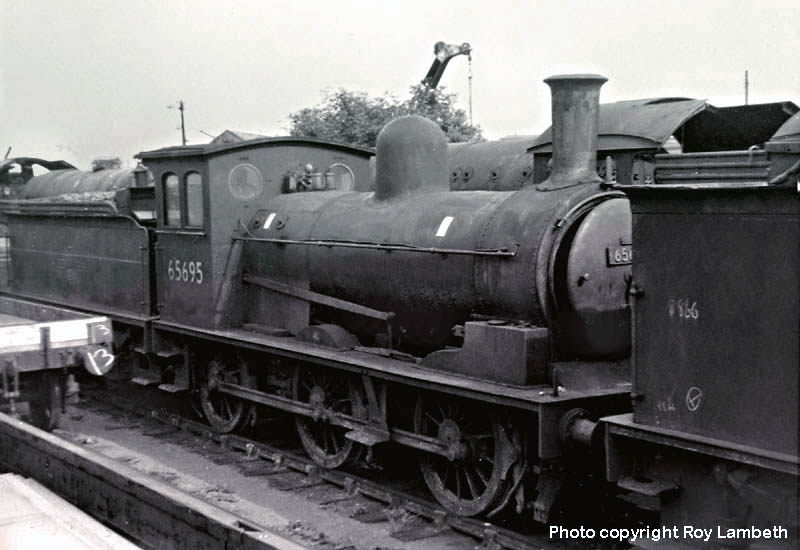
(Above) I saw many classes in the scrap yard including Q6, Q7, J21, J26, J27, J72, D49, B16, A5,A8,V1 and V3…the list is endless. Sadly, I had little pocket money to buy 120 film, so I wasn't able to take photographs on every single visit but here is a shot of Class J25 No 65695.
(Below) Preserved Class K4 3442 (61994) The Great Marquess passes milepost 1 just north of the rail access to Darlington North Road Works while running round the stock of the Ian Allan 'Darlington Marquess Railtour' on 3rd October 1964. The railtour was hauled by Class A3 4472 Flying Scotsman from Kings Cross to Harrogate, where it was connected to a portion from Leeds headed by 3442. Both engines then hauled the railtour via the Leeds Northern Line from Harrogate to Northallerton then Darlington Bank Top.

(Above) At Darlington the railtour was topped and tailed by 3442 and Class K1 No 62041 to Darlington North Road. Here, No 62041 draws the crowd outside Whessoe Works at Darlington North Road. The return trip was hauled by 3442 to York, where the railtour split - the main train returning to Kings Cross behind 4472.and 3442 returning its portion to Leeds.

(Above-Below) A lovely shot by Roy Lambeth of Class V2 No 60828 in the Wenslydale Bay at the north end of Northallerton's down island platform. Behind the camera are two water columns - one either side of the bay line - each with a water tank at ground level to catch any overspill. Roy recalls that one of them contained several large species of goldfish and carp that had been reared by the station master's wife. The fish were so tame they would take food from his hand - memories! Some things you never forget... (Below) The regular afternoon Darlington-Leeds service on the Leeds Northern line via Ripon, was normally allocated to one of Starbeck's D49 'Hunts'. On this day we were surprised to see Class V2 No 60809 The Snapper; The East Yorkshire Regiment - the Duke of York's Own, awaiting departure from the Saltburn Bay platform at Darlington Bank Top. Built at Darlington (No 4780) in August 1937 the loco was withdrawn from traffic at Darlington shed in July 1964.


(Above) We end the page with this shot of Wakefield based Class B1 No 61021 Reitbok heading south through the centre road of York station with an Inspector's Saloon in 1964. Click on 'Next Page' (below) to visit Roy's second page of archive BR steam photos in the 1960s.
Polite notice: All text and photographs are protected by copyright and reproduction is prohibited without the prior consent of the © owners. If you wish to discuss using the contents of this page the email address is below. Please note - this is not a 'clickable' mail-to link via Outlook Express. You will have to email manually.
dheycollection@ntlworld.com
chairman@dmm.org.uk

